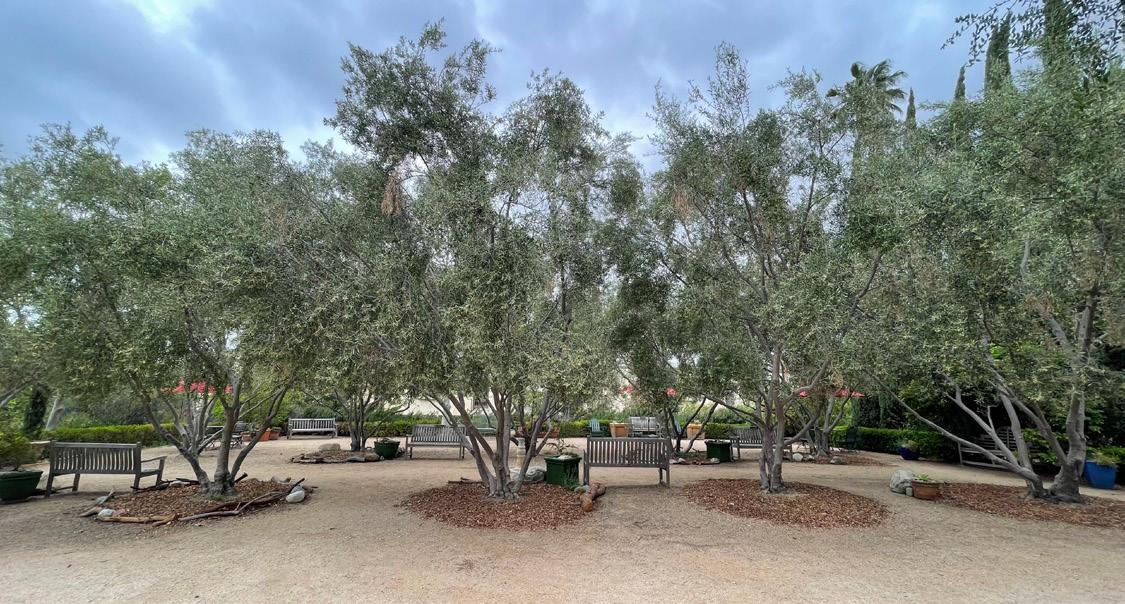
3 minute read
manzanita species
MANZANITA SPECIES: Arctostaphylos sp., soo-boó-chech or sobochesh (a Tongva general term for manzanitas)
ORIGIN: most species are from the California Floristic Province.
Advertisement
MATURE HEIGHT AND WIDTH: species and cultivars range in height from tall shrubs up to several meters to low-growing groundcovers.
GARDENING NOTES: there are 40+ California manzanita species adapted to a variety of conditions, with the California Native Plant society recognizing 117 native species and subspecies as of 2023.
three grass-like species
THREE GRASS-LIKE SPECIES: Muhlenbergia rigens (deer grass) (“su-ul” in Tongva), Elymus condensatus “Canyon Prince” (Canyon Prince wild rye) (“carrizo” in Spanish), Juncus acutus (spiny rush) (“psilj” in Kumeyaay)
ORIGIN: deer grass: southwestern US and Mexico growing north up to Redding in the California Floristic Province; Canyon Prince: western North America to the Great Lakes south into Mexico; spiny rush: native to western North America and scattered temperate and subtropical regions throughout the world.
MATURE HEIGHT AND WIDTH: deer grass: up to 5 ft. tall and 3-6 ft. wide; Canyon Prince: up to 5 ft. tall and spreading; spiny rush: 3-6 ft. tall and colony forming
GARDENING NOTES: all of these species perform best in full sun; they can also all be cut back periodically in order to maintain their shape and color; as its name does not suggest, deer mostly avoid deer grass in garden settings; rushes do best with riparian areas with plenty of water.
SHAPERS OF OUR SEASONAL WETLAND AREA, these “grasslike” species provide cover underneath trees and riparian shrubs. Although all three look like grasses, only deer grass and Canyon Prince wild rye are scientifically grasses. Spiny rush is, unsurprisingly, a rush. Although some grasses can be pests in the garden and surrounding ecosystems, these plants spread slowly and present no threats to garden integrity at Arlington.
Grasses Vs Rushes Vs Sedges
Grasses, rushes, and the very similar looking sedges are each in a different plant family — we won’t go into the taxonomic details here — and their similarity can give gardeners headaches. They can be distinguished through close inspection and use of this rhyme:
Sedges have edges,
Rushes are round, Grasses have nodes from the top to the ground. The visible parts of grasses include stems, leaves, and often a flower spike. However, we tend to think of them as only leaves, possibly because it is so difficult to identify the mangled parts in a mowed lawn.
Grass stems are generally hollow with solid joints (“nodes”) where the leaves attach. You can feel the nodes by gently running your hand along the stalk. Rushes have dense, round stems with leaves wrapped around; they do not have nodes. They are usually hard and smooth to the touch, although there are exceptions. Sedges, on the other hand, usually have solid, triangular stems. When feeling along the stalk, see if you can detect the vertex of a triangle — that’s probably a sedge!
Gardeners have an interest in distinguishing these plants because they have different growing requirements. And it’s always useful to be able to distinguish invasive terrors like Bermuda grass — an unwanted and vigorous “guest” in Southern California — from bunch grasses or sedges.
Rush Objects
The Kumeyaay and other Native Californians use spiny rush, along with basket rush (Juncus textilis), to weave functional and beautiful baskets. Spiny rush is first harvested by coppicing — cutting the plant to just above the ground — which promotes the growth of tall, straight shoots. These shoots are split and bundled together to form a foundation layer, around which stems of the more flexible basket rush are stitched in a spiral. Baskets made by the Kumeyaay using these traditional techniques are widely admired and the craft has experienced a recent revival.
three grass-like species

SCATTERED THROUGHOUT the garden, this large native buckwheat grows well in our hot summer climate even though it is native to the cool Channel Islands. Its felted leaves are much larger than those of other native Eriogonum species.
As you might have inferred from the name “Eriogonum giganteum,” it grows to gigantic stature in the right conditions. Its flowers are held in umbels, which are umbrella-shaped flower heads with many white flowers arranged in a flat circle. These umbels look a bit like a Catherine’s Wheel, a circular spinning firework named for St. Catherine of Alexandria, although the resemblance may be coincidence.
The Other Buckwheat
St. Catherine’s lace and other members of the native buckwheat genus Eriogonum are not closely related to “common buckwheat,” the source of the buckwheat flour you’ve eaten in baked goods or noodles. That flour is made using a cousin species (Fagopyrum esculentum) from Asia. There are nonetheless many Eriogonum species that are consumed by humans. Some Kumeyaay people use the roots of California buckwheat, for example, in a tea to treat stomach and heart ailments.










